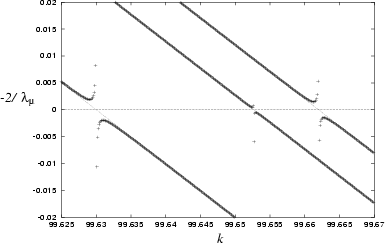Deterioration of the eigenstates with
For a given state ![]() returned by the generalized eigenproblem,
there will be an optimal adjustment to its
returned by the generalized eigenproblem,
there will be an optimal adjustment to its ![]() that can be made
to reduce the tension to a minimum.
(Generally this will be close to that returned by the
state-independent higher-order
correction formula (6.28)).
This adjustment has the effect of rescaling the eigenfunction so that its
node best approximates the Dirichlet boundary
that can be made
to reduce the tension to a minimum.
(Generally this will be close to that returned by the
state-independent higher-order
correction formula (6.28)).
This adjustment has the effect of rescaling the eigenfunction so that its
node best approximates the Dirichlet boundary ![]() .
However the tension minimum
.
However the tension minimum ![]() thus achievable
is much higher than the intrinsic basis limitation
thus achievable
is much higher than the intrinsic basis limitation
![]() , for most of the
, for most of the ![]() useful states, so is the dominant
error in practical applications.
Therefore it would be good to understand its origin.
useful states, so is the dominant
error in practical applications.
Therefore it would be good to understand its origin.
In Fig. 6.9 I show that the growth of tension error is
![]() with high accuracy.
There is relatively
little state-to-state fluctuation, that is,
with high accuracy.
There is relatively
little state-to-state fluctuation, that is, ![]() is not simply a random
quantity with growing mean (as would be expected if it were the square
of a zero-mean gaussian variable whose variance is given).
In the same system at lower
is not simply a random
quantity with growing mean (as would be expected if it were the square
of a zero-mean gaussian variable whose variance is given).
In the same system at lower ![]() I show the normal gradient, and wavefunction error
on the boundary for a set of states, in Fig. 6.11.
It is interesting to note that the error arises roughly in proportion to
I show the normal gradient, and wavefunction error
on the boundary for a set of states, in Fig. 6.11.
It is interesting to note that the error arises roughly in proportion to
![]() (or some power) on the boundary.
Also, the spatial frequency of the error at surprisingly low at large
(or some power) on the boundary.
Also, the spatial frequency of the error at surprisingly low at large ![]() .
The constant
.
The constant ![]() seems relatively independent of
seems relatively independent of ![]() (it certainly does not change
with any higher power than
(it certainly does not change
with any higher power than ![]() ).
).
This sixth power law is not affected by changing the basis, or by whether
![]() is near or far from the closest
is near or far from the closest ![]() .
The cause, as one would expect, seems to be the non-zero off-diagonal elements
of
.
The cause, as one would expect, seems to be the non-zero off-diagonal elements
of ![]() and
and ![]() , which causes the
eigenvectors
, which causes the
eigenvectors
![]() (in the scaling eigenfunction representation)
to be rotated slightly away from the unit vectors.
At first sight it might be thought that the quasi-diagonality of
(in the scaling eigenfunction representation)
to be rotated slightly away from the unit vectors.
At first sight it might be thought that the quasi-diagonality of ![]() is to
blame, because this appears with the lowest power of
is to
blame, because this appears with the lowest power of ![]() , namely
, namely ![]() .
However, Appendix I shows that in fact the 3rd and 4th
order terms in
.
However, Appendix I shows that in fact the 3rd and 4th
order terms in ![]() contain much more off-diagonal strength
for
contain much more off-diagonal strength
for
![]() .
This is evidenced by Fig. 6.10, which shows that by increasing the
off-diagonal strength of
.
This is evidenced by Fig. 6.10, which shows that by increasing the
off-diagonal strength of ![]() by controlled amounts, a new type of error
results. This shows that the off-diagonal strength of
by controlled amounts, a new type of error
results. This shows that the off-diagonal strength of ![]() in the standard
case of
in the standard
case of
![]() does not seem to
cause the sixth power law error growth.
does not seem to
cause the sixth power law error growth.
I have attempted to model the effect of the 3rd- and 4th-order in ![]() off-diagonal terms by applying them
in first-order perturbation theory to the generalized eigenproblem
(6.25) (in the scaling eigenfunction representation).
However, it seems that the perturbing effect of scaling eigenfunctions
with distant wavenumbers is divergent, and grows like
off-diagonal terms by applying them
in first-order perturbation theory to the generalized eigenproblem
(6.25) (in the scaling eigenfunction representation).
However, it seems that the perturbing effect of scaling eigenfunctions
with distant wavenumbers is divergent, and grows like ![]() not the
observed
not the
observed ![]() .
The role of these distant states is dubious because they fall outside the
wavenumber range
.
The role of these distant states is dubious because they fall outside the
wavenumber range
![]() encompassing
encompassing ![]() adjacent states.
It is unknown whether near or distant states are the cause of this error.
Clearly this is an area for more study.
adjacent states.
It is unknown whether near or distant states are the cause of this error.
Clearly this is an area for more study.
 |